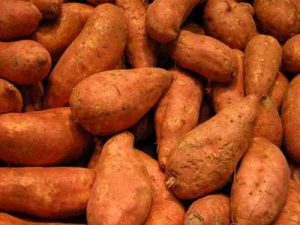What’s small, black, has six legs and causes a lot of damage to sweet potato crops?
The sweet potato weevil.
Once this pest is present and fields become highly infested, it’s very difficult to control. The weevil causes unsightly effects to the outside and inside of the sweet potato, making it hard to move the product through the market. In highly infested areas, the weevil can render potatoes useless and unable to eat.
Steven Long is an assistant director in the Department of Plant Industry at Clemson University and serves as South Carolina’s state regulatory official. He and his team deal with quarantines and prevent movement of the sweet potato weevil from infested areas.
In South Carolina, there is a statewide trapping program. Long traps at every known sweet potato field to ensure that he always has an active list of where the pest is in the state. “We try to deter and prevent movement of that pest from the known areas to other uninfected areas,” explains Long. “Really, the best thing folks can do is to not ever get the pest. What we tell farmers is be certain about where you’re buying your sweet potato seed from.”
Once you know where your seeds are coming from, Long says to inspect for clean stock, look for weevil damage, and be sure that you’re not transplanting the weevil to your land. “If you find that you do have the weevil, be sure that you’re not moving it around to your other fields through rotations. Don’t let it become established in your storage areas, and don’t aid in the movement,” Long stresses.
Long monitors areas for sweet potato weevil and sets up quarantines when needed. “We quarantine for two reasons: one is to prevent the movement of the pest, and two is to salvage marketing capabilities in other states,” says Long. “In South Carolina, if we didn’t do any trapping in the state, we couldn’t tell North Carolina or Georgia, for instance, that we know where the weevil is. Their regulatory officials might be forced to assume that the pest is everywhere.”
According to Long, the most important thing a grower can do is buy quality stock. He says those potatoes have specifically been inspected at least three times per growing season by highly trained inspectors who are looking for any kind of insect or pest damage. This is a higher level of certification that can give growers an added level of security and assurance that the potatoes should not be infested.
The sweet potato weevil doesn’t move very well on its own, says Long. “It’s unlikely that it will travel on its own or through wind or other environmental conditions to get to your farm,” he says. “The only way that you’ll ever get it is if you bring it in yourself.”
Long points out that one of the problems with common names of a lot of pests is people tend to think that these pests only affect the plant that’s in the name, like the sweet potato weevil. However, sweet potato weevil also infests native morning glories in South Carolina, Georgia and Florida. Native morning glories grow very well in coastal areas and can become alternative hosts that allow weevil populations to build up.
Share this Post










